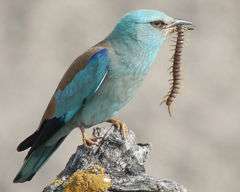Coracias
| Coracias | |
|---|---|
 | |
| Adult European roller | |
| Scientific classification | |
| Kingdom: | Animalia |
| Phylum: | Chordata |
| Class: | Aves |
| Order: | Coraciiformes |
| Family: | Coraciidae |
| Genus: | Coracias Linnaeus, 1758 |
| Species | |
|
8, see text | |
| Synonyms | |
|
Galgulus Brisson, 1760 | |
Coracias is a genus of the rollers, an Old World family of near passerine birds related to the kingfishers and bee-eaters. They share the colourful appearance of those groups, blues and browns predominating. The two outer front toes are connected, but not the inner one.
Coracias rollers are watch-and wait hunters. They sit in a tree or on a post before descending on their prey and carrying it back in the beak to a perch before dismembering it. A wide range of terrestrial invertebrates, and small vertebrates such as frogs, lizards rodents and young birds, is taken. Their prey includes items avoided by many other birds, such as hairy caterpillars, insects with warning colouration and snakes.[1] They often perch prominently whilst hunting, like giant shrikes.
The name is from the Ancient Greek korakías (κορακίας),[2] derived from korax (κόραξ, ‘raven, crow’).[3] Aristotle described the coracias as a bird as big as a crow but has a red beak,[4] which some believe to be the chough.[5]
The species in taxonomic order are:
- European roller Coracias garrulus
- Abyssinian roller Coracias abyssinicus
- Lilac-breasted roller Coracias caudatus
- Racket-tailed roller Coracias spatulatus
- Rufous-crowned roller Coracias noevius
- Indian roller Coracias benghalensis
- Purple-winged roller Coracias temminckii
- Blue-bellied roller Coracias cyanogaster
References
- ↑ Fry, C. H.; Fry, K. (30 June 2010). Kingfishers, Bee-eaters and Rollers. Bloomsbury Publishing. pp. 15–16. ISBN 978-1408134573. OCLC 25547477.
- ↑ André Jean François Marie Brochant de Villers; Alexandre Brongniart; Pierre Jean François Turpin (1818). Dictionnaire des sciences naturelles (in French). Levrault. p. 349.
- ↑ Craig, John (1854). A New Universal, Technological, Etymological, and Pronouncing Dictionary of the English Language. p. 407.
- ↑ Camus, Armand-Gaston (1783). Histoire des animaux d'Aristote (in French). Chez la veuve Desaint. p. 225.
- ↑ Greek Word Study Tool
- Kingfishers, Bee-eaters and Rollers by Fry, Fry and Harris, ISBN 0-7136-8028-8
External links
- Roller videos on the Internet Bird Collection